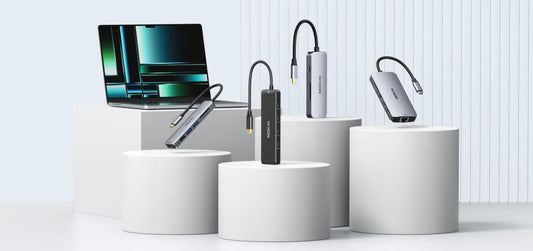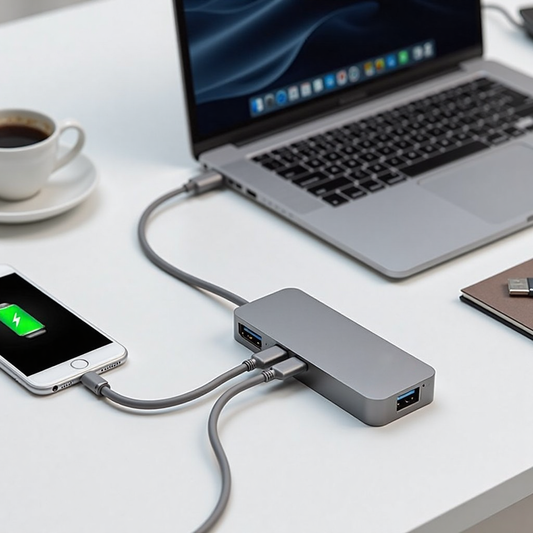To Enjoy Better Performance Between the Connection of HDMI & USB
Contents
I.Introduction
——————————
USB (Universal Serial Bus) and HDMI (High-Definition Multimedia Interface) connections are both incredibly important in the modern digital landscape. Here's a brief introduction to their significance:
USB is the most widely used standard for connecting a wide variety of peripheral devices to computers and other electronic devices. It provides a standardized way to transfer data, deliver power, and communicate between devices. The latest USB standards, such as USB 3.1 and USB C, offer faster data transfer speeds, increased power delivery capabilities, and more versatile connectors.
HDMI is the standard for high-quality digital video and audio transmission between devices. It allows the seamless connection of devices like computers, televisions, projectors, and gaming consoles, enabling the display of high-resolution content, supporting the transfer of uncompressed digital video and audio signals, ensuring the best possible image and sound quality. HDMI connections are crucial for setting up multi-display setups, connecting external displays, and integrating audio-visual components in home entertainment systems.

Can you convert a USB A to USB C?
With the progress and development of science and technology, the evolution of the port from the original beginning of the USB A port gradually evolved into USB C port, Lightning port and other types of interfaces, the connection between the different interfaces needs to act as a suitable bridge to ensure that the equipment perfectly running and productivity boosting.Let's figure it out.
II.USB Connectivity Solutions
——————————
A.USB A to USB C adapter
1. Explain the function, advantages and wide compatibility of usb a to usb c adapter
USB-A to USB-C adapters serve as a crucial bridge between the older USB A standard and the newer, more versatile USB C interface. These adapters perform several key functions:
Backward Compatibility: USB-A has been the prevalent connector for many years, found in a wide range of devices like keyboards, mice, external hard drives, and flash drives.
USB-C is the emerging standard, gradually replacing USB-A in newer laptops, smartphones, and other modern electronics.
USB-A to USB-C adapters allow users to continue using their existing USB A devices with the latest USB-C equipped devices, ensuring seamless connectivity and avoiding the need to replace compatible peripherals.
Data Transfer and Power Delivery: These adapters facilitate the transfer of data between the connected USB A device and the USB-C port, enabling efficient file transfers and device communication.
Widespread Compatibility: USB-A to USB-C adapters are widely compatible with a vast array of devices, from laptops and desktops to smartphones, tablets, and gaming consoles.
This versatility ensures that users can easily connect their USB-A peripherals, such as mice, keyboards, external storage, and even printers, to the latest USB-C-enabled devices.
2.Take some real example in daily use
We can benefit a lot with USB A to USB C adapter during daily use, for instance: connecting a USB-A flash drive to a USB-C laptop for file transfers, charging a USB-A smartphone or power bank via a USB-C wall adapter, linking a USB-A external hard drive to a USB-C-equipped gaming console for media storage and playback, integrating a USB-A webcam or microphone with a USB-C-enabled desktop computer or laptop for video conferencing etc.
So let’s get back to the question: Can you convert a USB A to USB C?
The answer is Certainly! USB A to USB C adapters or cables allow you to connect legacy USB devices to the newer USB-C ports. These adapters have a traditional USB A plug on one end and a USB C plug on the other. This conversion enables you to use your existing USB A peripherals, such as flash drives, mouse, or keyboards, with USB-C-equipped devices like laptops, smartphones, or tablets. The adapter facilitates data transfer and, in some cases, may even support power delivery, allowing you to charge your USB C device using a USB A power source. This converter provides a seamless way to bridge the gap between older USB A and the latest USB C technology.

B.Comparison between USB A to USB B and USB A to USB C
Here let’s watch a short video to get more information about it:
What is the difference between USB-C and USB-B?

The key differences between USB-C and USB-B connectors are as follow:
1. Reversibility: USB-C connectors are reversible, allowing the cable to be plugged in either way up, whereas USB-B connectors have a specific orientation.
2. Size and Shape: USB-C is a smaller, more compact connector compared to the larger rectangular USB-B.
3. Capabilities: USB-C supports higher data transfer rates, faster charging, and the ability to transmit video and audio signals, whereas USB-B is limited to data transfer and lower power delivery.
4. Ubiquity: USB-C is the newer, more widely adopted standard, found in modern laptops, smartphones, and other devices, while USB-B is more commonly used for older peripheral devices like printers and scanners.
The key differences between USB-A to USB-B and USB-B to USB-C are as follow:
USB-A to USB-B: Used for connecting peripheral devices like printers, scanners, and external hard drives to computers. Provides data transfer capabilities but limited power delivery. Commonly found in older electronic devices.
USB-B to USB-C: Enables connection between legacy USB-B devices and modern USB-C ports on laptops, smartphones, and other devices. Provides data transfer as well as improved power delivery for charging connected devices.Facilitates the integration of older peripherals with newer USB-C equipped systems, ensuring backward compatibility.
The advantages of these adapters include extended device compatibility, data transfer, and power delivery capabilities, allowing users to seamlessly connect a wider range of devices to their latest technology.
C.Unveil USBA to USBC Cable
1. Standard USB-A to USB-C cable: Provides data transfer and basic power delivery.
2. USB-A to USB-C with Power Delivery: Enables faster charging and power delivery for devices.
3. USB-A to USB-C with DisplayPort or HDMI: Supports video output for connecting displays or TVs.
4. USB-A to USB-C with Thunderbolt 3/4: Allows for high-speed data transfers and advanced features,like 40Gbps data transfer, 5K@60Hz, 8K@30Hz or dual 4K@60Hz HD display
These cables ensure seamless integration and compatibility between older USB-A devices and modern USB-C-equipped systems, enabling users to maximize the utility of their existing peripherals.
How can you tell if a USB cable is a data transfer cable?
To determine if a USB cable is a data transfer cable, you can look for the following indicators:
1. Cable Markings: Look for any labeling or printing on the cable that indicates it supports data transfer, such as "Data" or "Data Transfer" printed on the cable or its connectors.
2. USB Specification: Check the cable's packaging or product information to see if it specifies the USB version or standard it supports, such as USB 2.0, USB 3.0, or USB 3.1. Higher USB versions generally indicate better data transfer capabilities.
3. Connector Type: USB-C and USB 3.x connectors (USB-A, USB-B, USB-C) typically support faster data transfer speeds compared to older USB 2.0 connectors.
4. Cable Thickness: Data transfer cables are often thicker and more robust than basic charging cables, as they require more conductors to support higher data rates.
By looking for these visual cues, you can quickly determine if a USB cable is designed for data transfer or primarily for power/charging purposes.
III. HDMI Connectivity Solutions
——————————
A.HDMI Type C to USB A adapter
An HDMI USB-C to USB adapter allows you to connect HDMI-enabled devices like laptops, smartphones, or tablets to USB ports. This can be useful for displaying content on larger screens or connecting peripherals. The main advantages of this adapter are:
1. Versatility - It enables cross-compatibility between HDMI and USB devices.
2. Convenience - It eliminates the need for multiple cables or dongles.
3. Improved connectivity - It provides a simple way to extend the display or transfer data between HDMI and USB devices.
4. Compact design - The adapter is typically small and portable, making it easy to carry around.
In daily life, we can make good use of HDMI USB-C to USB adapter to realize our indeed needs with display equipment. Here are some examples of how an HDMI USB-C to USB adapter can be used in daily life: Connecting a USB-C laptop to a TV or monitor for presentations, movie viewing mirroring the laptop's display, USB projector for classroom; linking a USB-C smartphone or tablet to a TV to share photos, videos, or play mobile games on a larger screen; enabling a USB-C camera or gaming console to be plugged into a TV or monitor for improved viewing experience, providing a way to connect USB-C devices like external hard drives or USB hubs to computers with regular USB ports.
The wide compatibility of this adapter makes it useful across a variety of devices, including laptops, smartphones, tablets, cameras, gaming systems, and more - truly versatile for daily digital connectivity needs.
How do I run HDMI through USB-C?
To run HDMI through a USB-C port, you'll need an HDMI USB-C to USB adapter. Here's how it works:
1. Plug the HDMI end of the adapter into the HDMI port of your source device (laptop, smartphone, etc.).
2. Connect the USB-C end of the adapter to the USB-C port on your device.
3. The adapter will convert the HDMI signal to a format that can be transmitted through the USB-C connection.
4. This allows you to output the HDMI video and audio to an external display, TV, or projector connected to the other end of the adapter.
5. The adapter provides a simple, one-cable solution to connect HDMI devices to USB-C enabled devices.
B. Explore the HDMI Hub

An HDMI hub is a device that allows you to connect multiple HDMI-enabled devices to a single HDMI input on a display or TV. The main functions of an HDMI hub include:
1. Expanded connectivity: The hub provides additional HDMI ports, typically 2-4, so you can connect more sources like laptops, gaming consoles, streaming devices, etc. to the same display.
2. Simplified setup: Instead of constantly swapping HDMI cables between devices, the hub lets you leave everything plugged in and easily switch between inputs using the hub's controls.
3. Signal distribution: The hub can split and distribute the HDMI signal from one source to multiple displays, allowing you to mirror or extend your screen across different monitors.
4. Enhanced video quality: Many HDMI hubs support features like 4K resolution, HDR, and high refresh rates to deliver high-quality video and audio.
5. Compact design: HDMI hubs are often compact and portable, making them convenient for home, office, or on-the-go use.
The HDMI hub simplifies HDMI connectivity and expands the number of devices that can be used with a single display or TV.
HDMI hubs significantly expand the connectivity options for HDMI-enabled devices. By providing multiple HDMI input ports, these hubs allow you to connect several sources, such as laptops, game consoles, streaming devices, and media players, to a single display.
The key advantages of an HDMI hub's multi-port connectivity include:
Convenience - Easily switch between connected devices without constantly unplugging and reconnecting HDMI cables.
Expandability - Add more HDMI devices without running out of ports on your display.
Flexibility - Position devices in different locations and have them all feed into the central hub.
Improved organization - Reduce cable clutter by consolidating connections into a single hub.
Simultaneous use - Some hubs enable mirroring or extending content across multiple displays.
The HDMI hub's multi-port design greatly enhances the connectivity and usability of HDMI-based systems.
How to add HDMI ports to TV?
To add more HDMI ports to your TV, you can use an HDMI hub or splitter:
HDMI hub - Connect the hub to your TV's existing HDMI port, then plug in additional HDMI devices to the hub's multiple input ports.
HDMI splitter - Attach the splitter to your TV's HDMI port and it will create two or more HDMI outputs, allowing you to connect multiple devices.
This expands your TV's connectivity options without having to replace the TV itself.
C.USB Switcher and Its Use in Real Life
A USB switcher is a device that allows you to easily switch between multiple USB devices connected to a single USB port. This can be particularly useful in real-life scenarios such as:
1. Sharing a single USB port between a laptop and a USB hub or docking station to access various peripherals.
2. Switching between a mouse, keyboard, and webcam when using a desktop computer or tablet with limited USB ports.
3. Quickly transitioning between a USB storage drive and a USB charger when charging a smartphone or tablet.
4. Effortlessly toggling between a game controller and a USB microphone when using a PC for gaming and streaming.
5. Simplifying the connection of USB devices in a workspace or home office with multiple computers.
The USB switcher provides a convenient way to maximize the utility of limited USB ports.It plays a crucial role in device sharing and management, especially in settings with limited USB ports. They enable users to seamlessly connect and switch between multiple USB devices, such as keyboards, mouse, storage drives, and peripherals, without the need for constant cable swapping or device unplugging. This improves efficiency, reduces clutter, and enhances productivity in both personal and professional environments.
IV.Conclusion
——————————
USB and HDMI connectivity solutions are essential for seamless integration and sharing of devices in modern digital ecosystems. They enable cross-compatibility, expandability, and efficient management of various electronics, from laptops and smartphones to gaming consoles and displays. These connectivity tools simplify setups, enhance productivity, and provide flexible, high-quality data and multimedia experiences across a wide range of applications.
HDMI USB-C Adapter: Facilitates cross-device connection and display mirroring, enabling convenient presentations, media sharing, and extended connectivity between laptops, smartphones, and displays.
HDMI Hub: Expands limited HDMI port availability, streamlining multi-device setups in home entertainment, office, and educational environments.
USB Switcher: Optimizes limited USB ports, allowing seamless toggling between keyboards, mice, storage, and other peripherals for enhanced productivity and workspace management.
These connectivity solutions address common challenges, improve usability, and unlock the full potential of today's diverse digital ecosystems.
When purchasing HDMI/USB connectivity devices, consider compatibility with your specific devices, support for advanced features like 4K, and build quality for durability. Check reviews and opt for reputable brands. Ensure cables are long enough for your setup, and be mindful of power requirements, especially for hubs and docking stations. With the right products, you can seamlessly integrate your devices and optimize your digital experiences.
Here are some of the products links that worth buying:

MOKiN 13-IN-1 USB-C Laptop Charging Station with 2.26-inch LCD Smart Display









